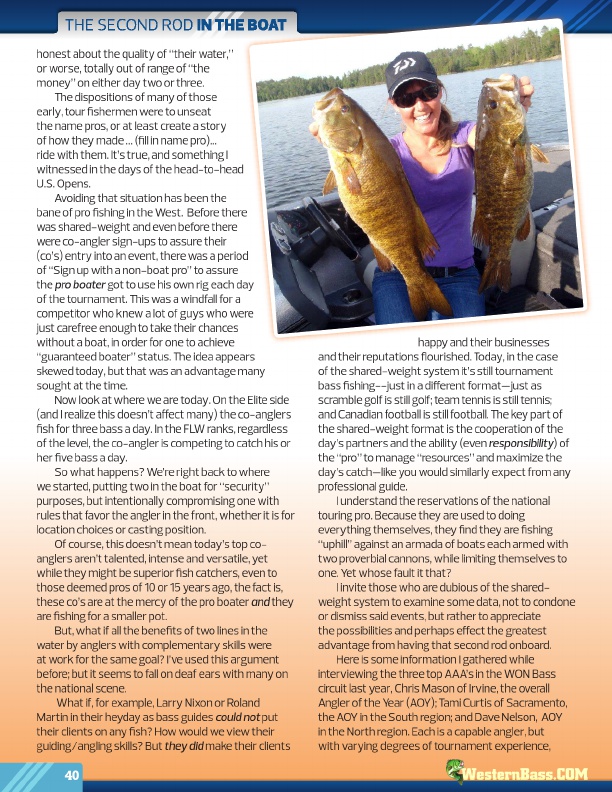
THE SECOND ROD IN THE BOAT
honest about the quality of “their water,” or worse, totally out of range of “the money” on either day two or three.
The dispositions of many of those early, tour fishermen were to unseat the name pros, or at least create a story of how they made … (fill in name pro)… ride with them. It’s true, and something I witnessed in the days of the head-to-head U.S. Opens.
Avoiding that situation has been the bane of pro fishing in the West. Before there was shared-weight and even before there were co-angler sign-ups to assure their (co’s) entry into an event, there was a period of “Sign up with a non-boat pro” to assure the pro boater got to use his own rig each day of the tournament. This was a windfall for a competitor who knew a lot of guys who were just carefree enough to take their chances without a boat, in order for one to achieve “guaranteed boater” status. The idea appears skewed today, but that was an advantage many sought at the time.
Now look at where we are today. On the Elite side (and I realize this doesn’t affect many) the co-anglers fish for three bass a day. In the FLW ranks, regardless of the level, the co-angler is competing to catch his or her five bass a day.
So what happens? We’re right back to where we started, putting two in the boat for “security” purposes, but intentionally compromising one with rules that favor the angler in the front, whether it is for location choices or casting position.
Of course, this doesn’t mean today’s top co- anglers aren’t talented, intense and versatile, yet while they might be superior fish catchers, even to those deemed pros of 10 or 15 years ago, the fact is, these co’s are at the mercy of the pro boater and they are fishing for a smaller pot.
But, what if all the benefits of two lines in the water by anglers with complementary skills were at work for the same goal? I’ve used this argument before; but it seems to fall on deaf ears with many on the national scene.
What if, for example, Larry Nixon or Roland Martin in their heyday as bass guides could not put their clients on any fish? How would we view their guiding/angling skills? But they did make their clients
40
happy and their businesses and their reputations flourished. Today, in the case of the shared-weight system it’s still tournament bass fishing--just in a different format—just as scramble golf is still golf; team tennis is still tennis; and Canadian football is still football. The key part of the shared-weight format is the cooperation of the day’s partners and the ability (even responsibility ) of the “pro” to manage “resources” and maximize the day’s catch—like you would similarly expect from any professional guide.
I understand the reservations of the national touring pro. Because they are used to doing everything themselves, they find they are fishing “uphill” against an armada of boats each armed with two proverbial cannons, while limiting themselves to one. Yet whose fault it that?
I invite those who are dubious of the shared- weight system to examine some data, not to condone or dismiss said events, but rather to appreciate the possibilities and perhaps effect the greatest advantage from having that second rod onboard.
Here is some information I gathered while interviewing the three top AAA’s in the WON Bass circuit last year, Chris Mason of Irvine, the overall Angler of the Year (AOY); Tami Curtis of Sacramento, the AOY in the South region; and Dave Nelson, AOY in the North region. Each is a capable angler, but with varying degrees of tournament experience,